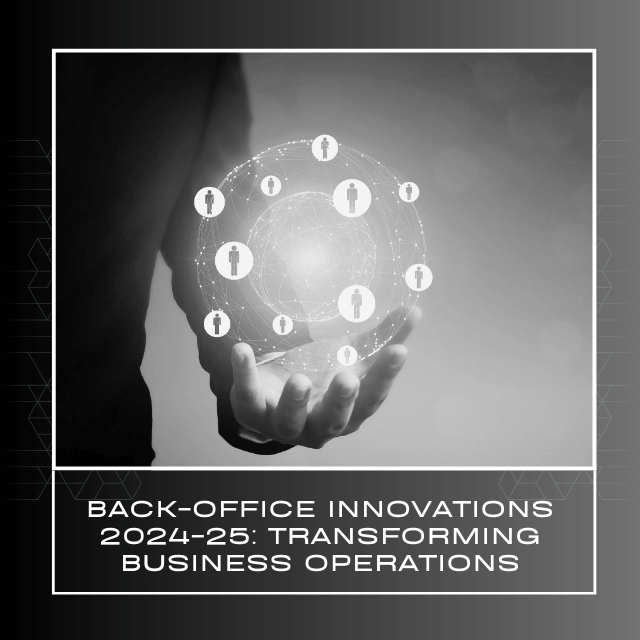The business world is split into two domains: front office and back office. The front office is directly engaged with customers, while the back office performs functions in the background to offer critical support that propels a business. This comprehensive guide is dedicated to explaining the fundamental features and capabilities served by back offices.
What are back office operations?
Back office operations include administrative and supporting functions that act as a backbone for any organization. It encompasses the unseen work, making sure that everything that takes place in an organization runs smoothly while keeping the front office free to concentrate on other crucial and customer-centered jobs, including interacting with them for their issues and concerns.
For example, the back office works as a chef who prepares the meals in the hotel or an accountant who manages the finances; however, a customer’s eye only meets the staff and manager who work on getting their food orders. Without the efficient efforts of these back office operations, it might become difficult for the hotel to run the business smoothly.
Similar to the example, there are multiple roles a back office plays; we have described some of them below:
Back office operations consist of an array of processes. We presented some major ones that help in structuring the business processes.
- Accounting and Finance: It ensures healthy terms of finance, which is handling accounts payable and receivable, payroll processing, conducting the required financial reporting, and budgeting.
- Human Resources (HR): HR retains responsibility for all aspects of employee life cycles, including recruitment and onboarding, payroll, benefits administration, and employee relations.
- Information Technology (IT): The IT department is responsible for the smooth processing of the computer system, network infrastructure, and software applications.
- Legal: It handles the contracts, related regulatory compliance, and all legal issues that may be involved.
- Compliance: The employees at the back office ensure that the organization meets up with all the related laws and regulations. This includes privacy in data, taxes, and the specific requirements of the concerned industries.
- Procurement: This is the process of acquiring goods and services required for the operations within the organization.
- Customer Service: While often related to the front office, there are certain back-office activities that relate to customer inquiries or returns.
Innovations revolutionizing the Back Office Era
The back office, once considered an engine room of a business that allowed processes to run in the background, has been through a revolution. The combination of the latest technologies and strategic shifts has remodeled the response of businesses towards their internal activities. Here we are offering a closer look at some of the key innovations driving this change in the BPO industry.
Automation:
Automation is redesigning many back office functions, and Robotic Process Automation (RPA), along with Artificial Intelligence (AI), is taking center stage in the current era. The most mundane, repetitive, and time-consuming tasks are automated in order to aid people in being more focused on strategic and value-added activities.
AI-powered tools are capable of analyzing complex data sets, providing predictive insights, and improving decision-making.
Cloud-based Solutions:
Currently, this is the most preferred option for back-office solutions, thanks to its scalability and cost-effectiveness. Additionally, its hassle-free access to data and applications, along with the independence of working from anywhere, is another reason behind its popularity.
Furthermore, these solutions offer the ability to scale up or down according to business needs, hence being very suitable for businesses looking to grow without making massive infrastructure investments. Also, cloud systems help integrate well with other enterprise tools in a systematic way such that data flows very smoothly across departments.
Consequently, cloud adoption reduces IT maintenance burdens, makes operations very efficient, and allows businesses to pivot much more quickly in relation to market demands.
Data Analytics:
Data has become the lifeblood of back-office operations as it ensures that businesses gain insights into processes, identify areas for improvement, and make informed decisions. At the same time, it has empowered companies with optimized processes, reduced costs, and enhanced customer experiences.
Employee Experience:
This segment is now taking center stage, turning into a very strong element of back-office operations. The businesses have realized the importance of an inspired and engaged workforce; therefore, they are all set to invest in tools and technologies that help with employee well-being, productivity, and job satisfaction.
Customer-Centricity:
Back office operations are no longer standalone. The growing integration of back-office operations with the front-line customer-serving functions of the corporation is breaking down silos and is promoting the issue of alignment with a customer-centric culture into the overall goals of the customer experience.
The Importance of Back Office Operations
Though back-office operations are not always visible to the customers, they play a very critical role in the success of an organization. To begin with, back office operations streamline the processes, ensuring rapid order fulfillment, accurate reporting, and allocation offering efficiency. Additionally, it is a cost-effective way to manage the entire back office activity.
CONCLUSION
Back-office operations are the unsung heroes of business organizations. They work behind the scenes and ensure seamless operations for business sustainability. Moreover, understanding and optimizing these processes is what brings organizations greater efficiency, more accuracy, compliance with regulations, and eventually sustainability in success.
Furthermore, thanks to the modern advancements that are empowering back-office operations and promising even greater efficiency and cost savings. The continued improvements in automation, artificial intelligence, and cloud computing have led to another horizon for these operations.






